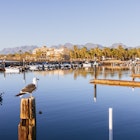

City breaks often mean too many people with not enough space © Marcio Jose Bastos Silva / Shutterstock
City breaks might be one of the most popular ways to travel, but the COVID-19 crisis will have dealt them a pretty severe blow. Maybe not a fatal one, but the damage is pretty serious.
The reasons are obvious: too many people, too little space.
The world’s most visited cities – Bangkok, Paris, London, Singapore, New York – get literally millions of visitors every year, and when you add those millions to the millions already living there… well, that’s a lot of people sharing the same real estate.

The problem is even more acute with smaller cities that are major tourist hubs: only 55,000 people live in Venice’s historic center, but they have to share those narrow lanes and canals with over 26 million visitors a year. That’s roughly the equivalent of New York City getting 4 billion visitors a year – a fair bit more than the 65 million it currently gets.
We now live in a world where social distancing and hyper vigilance are built-in prerequisites of virtually everything we do – and city breaks just aren’t designed to keep people at bay.
Consider what we actually do when we get there – after traveling through two busy airports. Where to first? A couple of beers in a nice bar? An amble through the historic town to get a sense of the place? A walk through that museum exhibition you’ve been looking forward to? Perhaps you’ve come at this time because the city is hosting a festival. Or maybe all of the above: with the right planning you can get a lot done in two days.
That’s both the pleasure and point of any good city – the ability to immerse yourself in its crowded spaces and embrace its myriad distractions. Cities offer endless opportunities for discovery and haphazard encounters. These days, though, those encounters can only occur 6ft (2m) apart and with the appropriate face covering.
Many years ago, at a Lonely Planet author conference, we were all asked for our favorite destinations to write about. Most of my colleagues expressed a preference for the undiscovered wilderness, in keeping with the spirit of the intrepid voyager. For me, it was cities.

My top places are a colorful, noisy thrum of organized chaos. Palermo, Bangkok, Ho Chi Minh City, New York and Los Angeles. Yes, even LA – that patchwork of individual towns strung together by a ribbon of highways. I like to lose myself in cities. Ask me to go for a long walk in the countryside and I’ll find a bunch of reasons not to; put me in a city and I’ll walk 20 miles before I’ve even noticed my feet are sore.
One of my best places to get sore feet in is Bangkok. An anonymous turn off a soi and I’m wandering down a side street criss-crossed by busy alleyways full of life: a small market, a cluster of workshops and a tiny outdoor restaurant beneath a plastic canopy, where you sit on little plastic chairs to eat freshly made pad thai while treacly Thai pop plays on a boombox strung from the branch of a bodhi tree.
Unremarkable on the face of it, but it’s these kinds of random experiences that make up my favorite travel memories. But that was before that knot of diners became a potential vector for a deadly virus.
The pandemic has profoundly altered how we experience cities – our own as much as those we visit. Half full is the new full in accommodations and restaurants, timed entries will be the norm for all attractions and live gigs and festivals have largely been parked.
Whatever you do and wherever you go there’ll be an accompanying level of anxiety: am I standing too close? How long do I have to wear this mask for? And while we’re all quickly adapting to new indoor protocols (line up patiently, put the mask on properly, use the hand sanitiser, stick to the one-way system and absolutely no more than four people at a time, please), they’re frankly not a lot of fun – unless you’re a fan of having your temperature taken every time you step inside.
After months of lockdown, there’s also a palpable sense of nervousness across the world about reopening too soon. Tourist officials and those who rely on international tourism to make a buck are all keen to welcome back visitors as soon as possible, but they’re acutely aware of the need for caution – and this is most obvious in cities, where the sudden arrival of masses of visitors looking to let their hair down and have a good time will be met with a bunch of reactions ranging from skepticism to outright hostility. Again, not a lot of fun.
And isn’t having fun the whole point of going on a city break?
I have no doubt that someday I’ll resume my urban wanderings, ready to recce the next city I find myself. For the time being, however, I’m going to stick to exploring a national park. At least in the wide-open spaces I don’t have to wear a mask.
You might also like:
Top socially distant outdoor activities around the US
Ask Lonely Planet: how do I cope with little to no travel?
Traveling right now is a personal choice: here's why I didn't go
Explore related stories








 Destination Practicalities11 things to know before visiting Ho Chi Minh City, Vietnam
Destination Practicalities11 things to know before visiting Ho Chi Minh City, VietnamOct 17, 2024 • 7 min read

